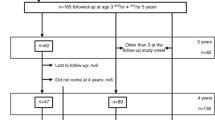Abstract
The long-term outcome of 20 preterm infants with extremely low birth weight and acute renal failure in the neonatal period was studied retrospectively over an 18-year period. Those with progressive renal disease are compared with those with normal renal function. Current mean age is 7.5±4.6 years (range 3.2–18.5 years). Nine patients showed deterioration in renal function (low GFR group). Increasing proteinuria, as determined by random urine protein/creatinine ratio (Up/c), correlated with deterioration in renal function (r=0.8, P<0.0001). Prominent risk factors for progression were Up/c >0.6 at 1 year of age [100% sensitivity, 75% positive predictive value (PPV), P<0.01], serum creatinine >0.6 mg/dl at 1 year of age (75% sensitivity, 80% PPV, P<0.01), and a tendency to obesity with body mass index >85th percentile (89% sensitivity, PPV 67%, P=0.03). Loss of renal mass and nephrocalcinosis were not prognostic indicators. This report begins to identify important clinical parameters that should lead to closer surveillance and potential treatment interventions for preservation of renal function in a growing population of surviving low birth weight individuals.



Similar content being viewed by others
References
Tommiska V, Heinonen K, Ikonen S, Kero P, Pokela M-L, Renlund M, Virtanen M, Fellman V (2001) A nationwide short-term follow-up study of extremely low birth weight infants born in Finland in 1996–1997. Pediatrics 107:1–9
Tóth-Heyn P, Drukker A, Guignard J-P (2000) The stressed neonatal kidney: from pathophysiology to clinical management of neonatal vasomotor nephropathy. Pediatr Nephrol 14:227–239
Bueva A, Guignard J-P (1994) Renal function in preterm neonates. Pediatr Res 36:572–577
Drukker A, Guignard J-P (2002) Renal aspects of the term and preterm infant: a selective update. Curr Opin Pediatr 14:175–182
Ballard J, Khoury J, Wedig K, Wang L, Eilers-Walsman B, Lipp R (1991) New Ballard score, expanded to include extremely premature infants. J Pediatr 119:417–423
Schwartz GJ, Brion LP, Spitzer A (1987) The use of plasma creatinine concentration for estimating glomerular filtration rate in infants, children, and adolescents. Pediatr Clin North Am 34:571–590
Slot C (1965) Plasma creatinine determination: a new and specific Jaffé reaction method. Scand J Clin Lab Invest 17:381–387
Abitbol C, Zilleruelo G, Freundlich M, Strauss J (1990) Quantitation of proteinuria with urinary protein/creatinine ratios and random urine dipsticks in nephrotic children. J Pediatr 116:243–247
Chiara A, Chirico G, Barbarini M, De Vecchi E, Rondini G (1989) Ultrasonic evaluation of kidney length in term and preterm infants. Eur J Pediatr 149:94–95
Sfakianakis GN (1991) Nuclear medicine in congenital urinary tract anomalies. In: Freeman L (ed) Nuclear medicine annual. Raven Press, New York, pp 129–192
Hegyi T, Anwar M, Carbone M, Ostfeld B, Hiatt M, Koons A, Pinto-Martin J, Paneth N (1996) Blood pressure ranges in premature infants. II. The first week of life. Pediatrics 97:336–342
Report from the Second Task Force on Blood Pressure Control in Children (1987) Pediatrics 79:5–6
Kuczmarski RJ, Ogden CL, Grummer-Strawn LM, Flegal KM, Guo SS, Wei R, Mei Z, Curtin LR, Roche AF, Johnson CL (2000) CDC Growth Charts: United States. Advance data from vital and health statistics, no. 314. National Center for Health Statistics, Hyattsville, Md., USA
Motulsky H (1995) Intuitive biostatics, 1st edn. Oxford University Press, New York, pp 207–262
Bernstein J, Risdon RA (1997) Renal system. In: Gilbert-Barness E (ed) Potter's pathology of the fetus and infant. Mosby, St. Louis, pp 863–866
Mañalich R, Reyes L, Herrera M, Melendi C, Fundora I (2000) Relationship between weight at birth and the number and size of renal glomeruli in humans: a histomorphometric study. Kidney Int 58:770–773
Keller G, Zimmer G, Mall G, Ritz E, Ahmann K (2003) Nephron number in patients with primary hypertension. N Engl J Med 348:101–108
Ingelfinger JR, Woods LL (2002) Perinatal programming, renal development, and adult renal function. Am J Hypertens 15:46S–49S
Barker DJP (1999) Fetal origins of cardiovascular disease. Ann Med 31 [Suppl 1]:3–6
Brenner B, Garcia DL, Anderson S (1988) Glomeruli and blood pressure. Less of one, more the other? Am J Hypertens 1:335–347
Merlet-Benichou C, Gilbert T, Vilar J, Moreau E, Freund N, Lelievre-Pegorier M (1999) Nephron number: variability is the rule. Lab Invest 79:515–527
Woods LL, Ingelfinger JR, Nyengaard JR, Rasch R (2001) Maternal protein restriction suppresses the newborn renin-angiotensin system and programs adult hypertension in rats. Pediatr Res 49:460–467
Merlet-Benichou C, Gilbert T, Muffat-Joly M, Lelievre-Pegorier M, Leroy B (1994) Intrauterine growth retardation leads to a permanent nephron deficit in the rat. Pediatr Nephrol 8:175–180
Praga M, Hernandez E, Morales E, Campos AP, Valero MA, Martinez MA, Leon M (2001) Clinical features and long-term outcome of obesity-associated focal segmental glomerulosclerosis. Nephrol Dial Transplant 16:1790–1798
Adelman RD, Restaino IG, Alon US, Blowey DL (2001) Proteinuria and focal segmental glomerulosclerosis in severely obese adolescents. J Pediatr 138:481–485
Rosenblum AL (2002) Fetal nutrition and insulin sensitivity: the genetic and environmental aspects of "thrift." J Pediatr 141:459–462
Acknowledgements
This work was supported in part by a grant from Children's Medical Services, Florida's Department of Health.
Author information
Authors and Affiliations
Corresponding author
Rights and permissions
About this article
Cite this article
Abitbol, C.L., Bauer, C.R., Montané, B. et al. Long-term follow-up of extremely low birth weight infants with neonatal renal failure. Pediatr Nephrol 18, 887–893 (2003). https://doi.org/10.1007/s00467-003-1186-1
Received:
Revised:
Accepted:
Published:
Issue Date:
DOI: https://doi.org/10.1007/s00467-003-1186-1



